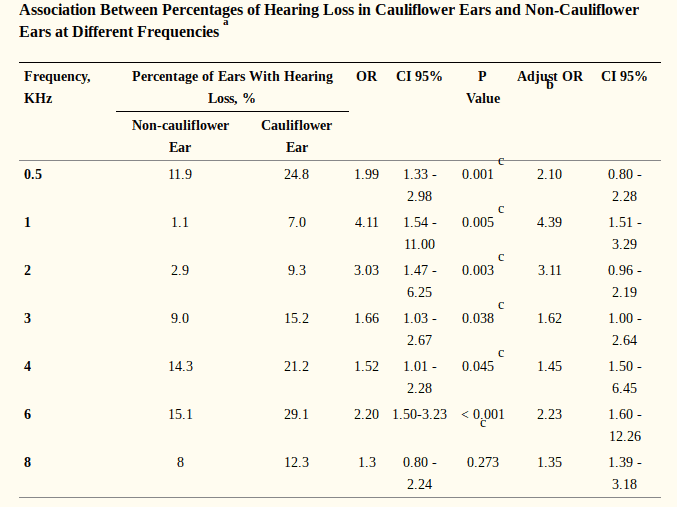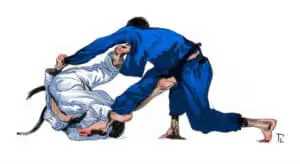Cauliflower is a common injury which occurs in BJJ. You have probably seen top athletes who have completely deformed or there may even be people at your gym that suffer from it. Now you want to know more about it and more importantly how to prevent cauliflower in BJJ? Because frankly it is pretty ugly.
How to prevent cauliflower ear in BJJ? To prevent cauliflower in BJJ you should wear a headgear which protects your ears from trauma, avoid pulling your head out of tight submissions particularly triangles, when you are in the standup position wrestle forehead to forehead not ear to ear and when you are on bottom use frames to prevent from people driving their shoulder and head into your ear.

What Is Cauliflower Ear?
What is cauliflower ear? Cauliflower ear is the result of the outer portion of the ear being damaged which leads to the connective tissue within the ear to separating from the cartilage. At the same blood vessels located within the ear bleed resulting in the ear swelling.

Is Cauliflower Ear Permanent?
Is cauliflower ear permanent? Cauliflower ear is permanent if the fluid within your ear has hardened. This takes between 3-8 days. So if you want your ear to return to normality you will have to treat your ear before the fluid hardens. It can take a further 4 weeks before the separated cartilage within your ear reattaches. If you don’t treat your ear before the fluid hardens your only treatment option is plastic surgery.
Does BJJ Give You Cauliflower Ear?

Does BJJ give you cauliflower ear? Yes, BJJ does give you cauliflower ear. BJJ is the sport with second highest rate of cauliflower ear behind wrestling. BJJ gives you cauliflower ear because of the friction that occurs between your ears and your opponent particularly when you are stuck in submissions, your opponent is putting pressure while on top of you and when you are shooting for takedowns.
Are Some People More Susceptible To Getting Cauliflower Ear From BJJ?
Are some people more susceptible to getting cauliflower ear from BJJ? Yes, BJJ athletes who have naturally stiff ears are more likely to get cauliflower ear. Ears that are bendy are less likely to be damaged from friction caused by BJJ. However no matter how flexible your ears are you will still be far more likely to get cauliflower compared to someone who wears a headgear.
Once you get cauliflower once you are more likely to get it again. This is because even after treating cauliflower ear effectively your ear will be stiffer and harder than it was before. This makes you more susceptible to suffering from the common friction your ears experience during BJJ.
How Common Is Cauliflower Ear In BJJ?

How common is cauliflower ear in BJJ? Cauliflower is common in BJJ with nearly all high level athletes having it in varying degrees. If you train for long enough it is very likely you will suffer from cauliflower ear. From my experience I would estimate 5% of white belts, 10-20% of blue belts, 25-30% of purple belts and 40-65% of brown and black belts have cauliflower ear.
However it is not common to develop severely deformed ears as this can be avoided by wearing headgear when your ears are sore and ensuring you drain and compress your ears when you develop even minor cauliflower ear. High level BJJ athletes who have very bad cauliflower ear refused to wear a headgear, didn’t drain their ears properly or at all and didn’t take a break from training when their ears were damaged. If you avoid those 3 mistakes even if you do develop cauliflower after you treat it correctly it will be difficult to notice unless someone is studying your ears.
How Long Does It Take To Get Cauliflower Ear From BJJ?

How long does it take to get cauliflower ear from BJJ? Cauliflower can take just a single event to occur. One takedown where you slam your ear into someones hip or attempting to pull your head out of a tight triangle is all it takes to get cauliflower ear. The chance of getting cauliflower at a single training session is low but the more you train the likelihood increases. After training for 2-4 years you will most likely have had at least one incident of cauliflower ear.
How Do I Know If I Have Cauliflower Ear From BJJ?
How do I know if I have cauliflower ear from BJJ? Your ear will be painful, tender, it will start to go red and will swell with blood. If your ear feels tender and hot to touch but there is no swelling this a sign of minor cauliflower ear and you should put on a headgear and ice your ear. If you ear is very swollen this a sign of significant cauliflower and you should drain it immediately.
Does Cauliflower Make You Look Tough?
Does cauliflower ear make you look tough? Cauliflower ear does not make you look tough. It makes your ears look strange. Cauliflower is a badge of honour among some BJJ athletes as some say it is a black belt you can always wear. However most people will just think your ears look ugly.
Steve Mocco (former Iowa wrestler) had a great quote about cauliflower ear, “cauliflower ears look retarded”.
Can Cauliflower Make You Deaf?
Can cauliflower make you deaf? Yes, cauliflower can make you deaf and affect your hearing. In a study of 340 wrestlers in Tehran, some with cauliflower and some without researchers found that wrestlers with cauliflower ear were much more likely to suffer from hearing loss across all frequencies except at 8KHz.

Does Cauliflower Ear Have Long Term Side Effects?
Does cauliflower ear have long term side effects? Yes, cauliflower does have long term side effects. Long term side effects include greater number of ear infections, ringing in ears, hearing loss, inability to wear headphones, difficulty cleaning ears and removing wax.
Fortunately long term side effects of cauliflower are usually minor and only occur when you have serious cauliflower that has not been properly treat over the years. You can avoid these long term side effects by following the treatment plan outlined below.
How Do I Treat Cauliflower Ear In BJJ?

How do I treat cauliflower ear in BJJ? The most effective way to treat cauliflower from BJJ is to prevent it by wearing a headgear. However if you have developed it you should stop training, ice your ear, drain the blood using a syringe, compress the ear with magnets, clip or a bandage and continue to drain and compress your ear until it returns to normal.
Stop Training
The first thing to do when you develop cauliflower ear is to stop training. If you continue training with a damaged ear you run the risk of increasing the swelling and potentially having your ear burst. This will cause your recovery to be prolonged and force you to take time off the mats. So for your body’s sake even if your cauliflower ear is mild stop training or at the very least put on a headgear.
Ice
After you develop cauliflower ear your ear will be painful and red. To reduce the pain you should ice your ear. Hold an ice pack on your ear for 30 minutes to numb the pain and reduce some of the swelling. Ice will not reduce all of the swelling but it can reduce some and will help with the pain.
Drain
Draining is the most important step in treating cauliflower ear. Your ear will be swollen and filled with blood. This blood will stay there until you remove it. The only way to remove it is to drain it. The best way to drain your ear is to take a long syringe and pull the blood out of your ear. It is not as painful as it looks and can be done within 10-15 mins. You can do this yourself but if it is your first time with cauliflower it is better to get a doctor to do it.
Compress
After draining compressing is the second most important step in treating cauliflower ear. If you don’t compress your ear after draining it will just refill with blood. The best way to compress your ear is to use rare earth magnets. Wrap the magnets in clothe to avoid the magnets digging into your ear. Compressing your ears is not very comfortable but it is a vital step in treating your ear. You should compress your ear all day and night.
Repeat
You need to continually drain and compress your ear until there is no blood left and your ear hardens and is no longer tender. This usually takes between 3-7 days. You will most likely need to drain your ear multiple times so don’t stress out if you can’t drain all the blood the first time or your ear refills.
Here is a video of Robert “Cyborg” Abreu getting his cauliflower ear treated
When Can I Return To BJJ After Cauliflower Ear?
When can I return to BJJ after cauliflower ear? You can return to training right away after cauliflower ear as long as you wear a headgear and have your ear compressed. I would wait a few days until your ear has hardened and is no longer refilling with blood. This usually occurs after 3-6 days.
If you don’t protect your ears when you return to training your likelihood of developing cauliflower again is higher as your ear is in a fragile state. A slight bump can cause the ear to refill with blood. It is best to wait until your ear is no longer sensitive and has hardened before training BJJ again.
Should I Quit BJJ Because Of Cauliflower Ear?
Should I quit BJJ because of cauliflower ear? No, you should not quit BJJ because of cauliflower because it can be prevented by wearing headgear. If you are very unlucky to get cauliflower ear while wearing a headgear you can drain your ear and compress it and your ear will return to normal. Don’t worry you will be able to keep your pretty ears and won’t end up looking like Randy Couture.
Joe Rogan has been training BJJ for 20 years and as he always wears a headgear doesn’t have any cauliflower ear.

Conclusion
Cauliflower ear is ugly can cause serious damage to your ears such as hearing loss. To prevent developing cauliflower ear you should wear headgear at all times during training. If you do develop cauliflower you must treat it immediately otherwise your ear will not return to normal. To avoid having a permanently deformed ear you must drain and compress your ear for a number of days until your ear hardens. Once this happens you can return to training. However once you have suffered cauliflower once you are more likely to get it again as your ear is now more stiff.
